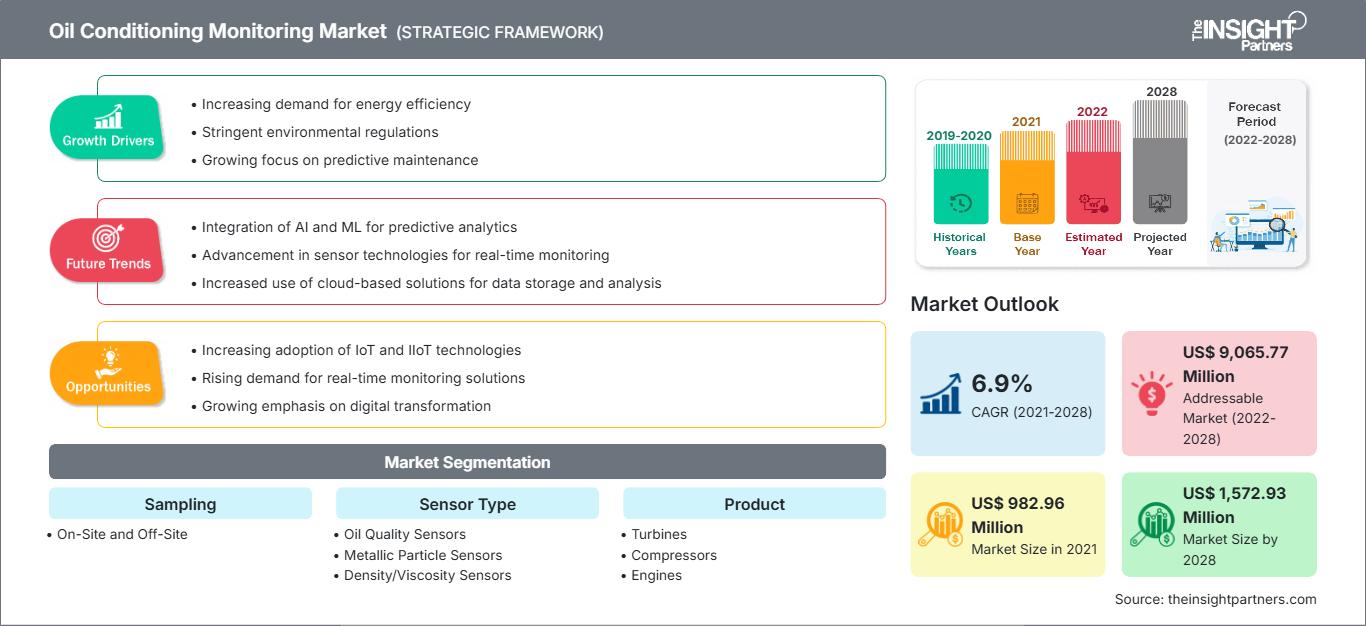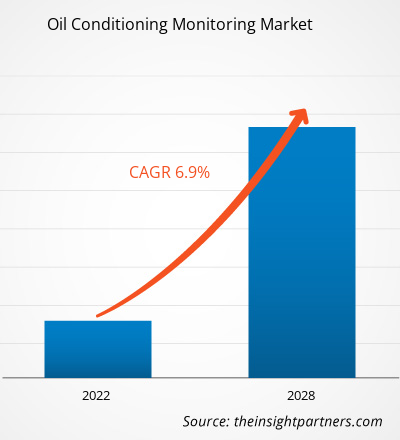预计油液调节监测市场规模将从 2021 年的 9.8296 亿美元增长到 2028 年的 15.7293 亿美元;预计 2021 年至 2028 年的复合年增长率为 6.9%。
工业物联网的应用正在大幅减少石油和天然气行业对环境的影响,包括提高效率、降低安全风险和减少差旅。石油和天然气公司正在关注工业物联网 (IIoT),因为它可以帮助他们节约能源、避免漏油和其他灾难,并减少碳排放。工业物联网还可以监测能源和资源消耗。智能技术几乎影响着石油和天然气供应链的每一个环节,从运营到与消费者的互动。供应链中的智能设备为石油和天然气行业提供了在商品化世界中竞争的机会,也为其在传统行业中快速实现现代化提供了机会。此外,物联网 (IoT) 还有潜力显著改进数据收集方法。石油和天然气行业几乎比任何其他行业都更重视效率和精确度。
自定义此报告以满足您的要求
您将免费获得任何报告的定制,包括本报告的部分内容,或国家级分析、Excel 数据包,以及为初创企业和大学提供超值优惠和折扣
油调节监测市场: 战略洞察

- 获取本报告的主要市场趋势。这个免费样本将包括数据分析,从市场趋势到估计和预测。
COVID-19 疫情对油品调节监测市场的影响
您将免费获得任何报告的定制,包括本报告的部分内容,或国家级分析、Excel 数据包,以及为初创企业和大学提供超值优惠和折扣
油调节监测市场: 战略洞察

- 获取本报告的主要市场趋势。这个免费样本将包括数据分析,从市场趋势到估计和预测。
COVID-19 疫情震撼了全球多个行业。封锁措施阻碍了包括制造业和 IT 在内的多个行业的运营。然而,快速消费品 (FMCG) 和制药等重要行业必须继续运营。石油行业正经历过去 12 个月来的第三次价格暴跌。在前两次冲击之后,该行业逐渐复苏,业务恢复正常。然而,这一次情况有所不同。当前的形势包括供应冲击、历史性的低需求和全球性的人道主义灾难。此外,该行业的财务和结构健康状况比以往的危机更糟。回报率低的原因是页岩油的引入、产量过剩以及忽视资本纪律的自由化金融市场。随着油价接近 30 年来的最低点和公众压力的增加,领导人意识到变革不可避免。COVID-19 问题正在加剧。因此,COVID-19 疫情及其影响正在对油调节监测市场造成严重破坏。
油调节监测市场洞察 全球发电需求增长推动油调节监测市场增长
预计未来几年全球能源消耗将增加,到 2035 年,由于全球人口预计增加以及中国和印度等发展中国家的经济和工业增长,年使用量将达到约 778 千焦耳。工业机械和其他设备设计师和制造商一直在寻找提高产品能源效率的方法,例如减少加热和冷却损失、改善传热和改进电动机。由于对可靠和基载电力的需求以及全球气候变化的威胁等因素,核电仍然是必需的。此外,核电是能源战略的重要组成部分,因为它是唯一大规模几乎无碳电力的来源。它生产全球约 20% 的电力和 60% 以上的低碳能源。核电站已成为满足日益增长的电力需求的一种能源。这些核电站面临着核燃料循环的问题,最终,这些设施在其生命周期内或在发生自然或人为灾害时需要退役,这推动了对设施内油质调节监测的需求。
基于抽样的市场洞察
根据抽样数据,全球油质调节监测市场分为现场和非现场。2020 年,非现场部分引领了油质调节监测市场,占据了更大的市场份额。基于传感器类型的市场洞察
根据传感器类型,油质调节监测市场分为油质传感器、金属颗粒传感器和密度/粘度传感器。 2020 年,油质传感器细分市场引领油质调节监测细分市场,占据市场最大份额。基于产品的市场洞察
根据产品,油质调节监测市场细分为涡轮机、压缩机、发动机、齿轮系统和液压系统。2020 年,涡轮机细分市场引领油质调节监测细分市场,占据市场最大份额。基于测量的市场洞察
根据测量,油质调节监测市场细分为温度、压力、密度、粘度、介电常数、总碱值/总碱值 (TAN/TBN)、水稀释、燃料稀释、烟灰和磨损颗粒。2020 年,粘度细分市场引领油质调节监测细分市场,占据市场最大份额。基于行业的市场洞察
根据行业,油质调节监测市场细分为运输、工业、石油和天然气、能源和电力以及采矿业。 2020年,运输行业引领了油液状态监测细分市场,占据了最大的市场份额。
油液状态监测市场的参与者采取并购和市场举措等策略来维持其市场地位。以下列出了一些主要参与者的进展:
- 2020年8月,ALS与总部位于罗切斯特的先进在线油液状态监测 (OCM) 解决方案开发商Poseidon Systems开始了战略合作。两家公司有一个共同的目标,那就是将 Poseidon Systems 屡获殊荣的在线 OCM 技术与 ALS 在油液分析和测试方面的经验相结合,从而实现 OCM 转型。
- 2020 年 8 月,Des-Case Corporation 宣布推出针对工业润滑资产的全新远程诊断监控订阅计划,该计划旨在提高工艺设备可靠性并延长润滑剂寿命,让客户安心无虞,因为他们的关键资产内部的润滑剂健康状况、清洁度和湿度都会受到实时监控。
油质调节监测市场
The Insight Partners 的分析师已详尽阐述了预测期内影响油质调节监测市场的区域趋势和因素。本节还探讨了北美、欧洲、亚太地区、中东和非洲以及南美和中美的油质调节监测市场细分和地域分布。
油调节监测市场报告范围
| 报告属性 | 细节 |
|---|---|
| 市场规模 2021 | US$ 982.96 Million |
| 市场规模 2028 | US$ 1,572.93 Million |
| 全球复合年增长率 (2021 - 2028) | 6.9% |
| 历史数据 | 2019-2020 |
| 预测期 | 2022-2028 |
| 涵盖的领域 |
By 采样
|
| 覆盖地区和国家 | 北美
|
| 市场领导者和主要公司简介 |
|
油调节监测市场参与者密度:了解其对业务动态的影响
油温监测市场正在快速增长,这得益于终端用户需求的不断增长,而这些需求的驱动因素包括消费者偏好的不断变化、技术进步以及对产品优势的认知度不断提高。随着需求的增长,企业正在扩展产品线,不断创新以满足消费者需求,并抓住新兴趋势,从而进一步推动市场增长。

- 获取 油调节监测市场 主要参与者概述
全球油液调节监测市场细分如下:
按采样
- 现场
- 场外
按传感器类型
- 油质传感器
- 金属颗粒传感器
- 密度/粘度传感器
按产品
- 涡轮机
- 压缩机
- 发动机
- 齿轮系统
- 液压系统
按测量
- 温度
- 压力
- 密度
- 粘度
- 介电常数
- 总碱值/总碱值
- 水稀释
- 燃料稀释
- 烟灰
- 磨损颗粒
按行业
- 运输
- 工业
- 石油和天然气
- 能源和电力
- 采矿
按地理位置
- 北美
- 美国
- 加拿大
- 墨西哥
- 欧洲
- 法国
- 德国
- 意大利
- 英国
- 俄罗斯
- 欧洲其他地区
- 亚太地区 (APAC)
- 中国
- 印度
- 韩国
- 日本
- 澳大利亚
- 亚太地区其他地区
- 中东和非洲 (MEA)
- 南非
- 沙特阿拉伯
- 阿联酋
- MEA 其他地区
- 南美洲 (SAM)
- 巴西
- 阿根廷
- SAM 其他地区
公司简介
- CM Technologies GmbH
- Des-Case
- Hydac Technology Limited
- Intertek Group Plc.
- Poseidon Systems
- Rheonics Group
- SGS SA
- Special Oilfield Services Co. LLC
- TAN Delta Systems Limited
- Veritas Petroleum Services
- 历史分析(2 年)、基准年、预测(7 年)及复合年增长率
- PEST和SWOT分析
- 市场规模、价值/数量 - 全球、区域、国家
- 行业和竞争格局
- Excel 数据集
近期报告
相关报告
客户评价
购买理由
- 明智的决策
- 了解市场动态
- 竞争分析
- 客户洞察
- 市场预测
- 风险规避
- 战略规划
- 投资论证
- 识别新兴市场
- 优化营销策略
- 提升运营效率
- 顺应监管趋势




















 获取免费样品 - 油调节监测市场
获取免费样品 - 油调节监测市场